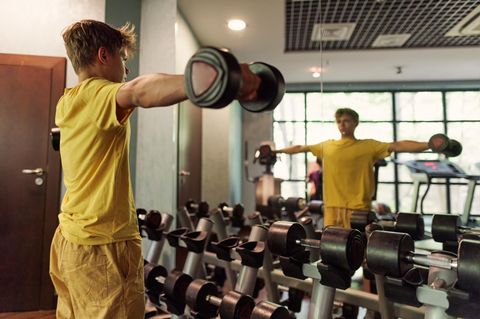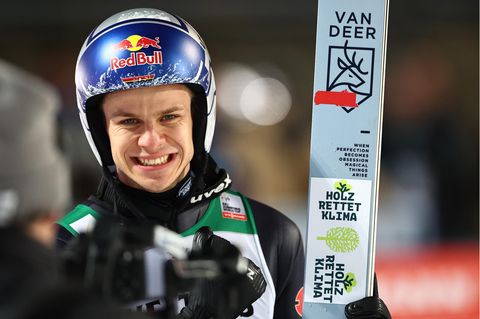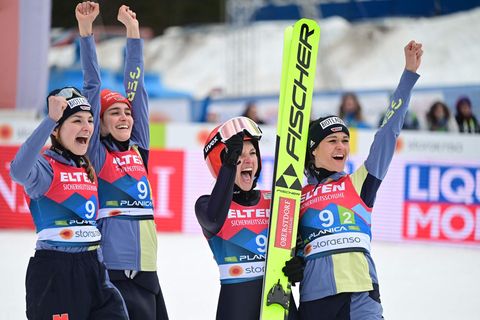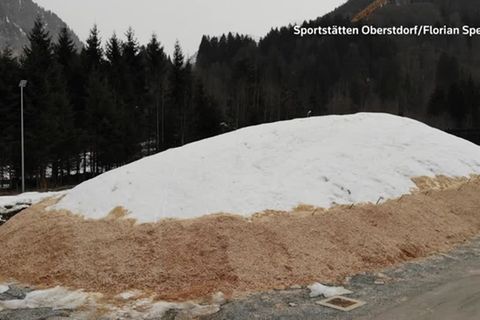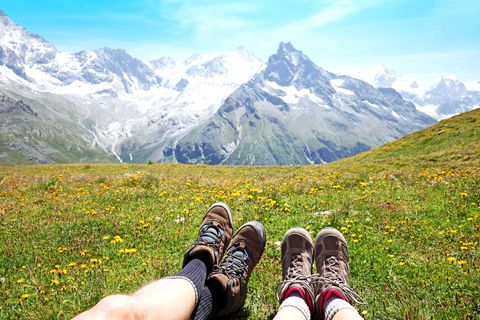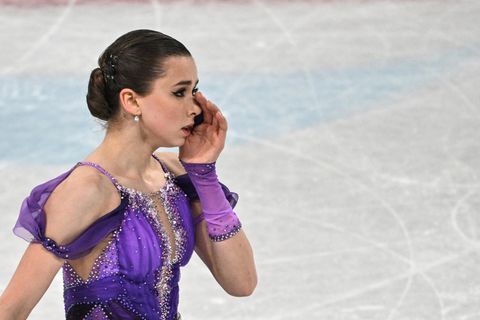They say the view from the top of the jump ramp at Oberstdorf, in the Bavarian Alps, is spectacular. Fifteen-year-old Andreas Buhl, however, has other things to think about. Holding on to the »Balken,« or beam, at the top of the ramp, he is locked into his big ski bindings, looking out through the visor of his crash helmet and thinking about his landing in the empty stadium hundreds of feet below. A moment later, he lets go, and, with his knees bent and his upper body leaning forward, races down the ramp keeping his long skis parallel in the icy »Spur« (tracks).
Then, he?s hurtling through the air, back flat, arms close to his body. For better flight, he keeps his upper body parallel with his skis, which are in a giant V position. »PLONK«: A few seconds later he lands with one leg in front of the other and his body bent forward as he touches the landing slope. »SWOOSH«: He glides down the landing hill before coming to a stop in front of the safety wall.
»Ja!« (Yes) he exclaims with satisfaction from under his helmet. Barely pausing to catch his breath, he puts his skis on his shoulders and walks to the lift to go back up for another jump. Meanwhile, his coach, who is watching from the »Schanzentisch,« the place at the end of the ramp where the jumpers take off, shouts feedback through a walkie-talkie. Then it begins all over again.
Whizzing through the cold winter air at more than 50 miles an hour is not everyone?s idea of an after-school work out. But for Andreas and his friends in Oberstdorf, ski jumping is no mere after-school work out. It?s a way of life. In the last few years, Germany has emerged as one of the leading ski jumping nations in the world. Thanks to regular coverage on German TV, young, good-looking pro stars like Martin Schmitt, 23, and Sven Hannawald, 26, have given the sport a glamorous image and a large following of mostly young female fans. And they have also inspired a whole new generation of German jumpers?who, like Andreas, are dedicating themselves to, well, perfecting the art of flying.
If this obsession seems unusual, you?ve probably never been to Oberstdorf, located in southern Bavaria near the German?Austrian Border. One of Germany?s most famous winter sports towns, Oberstdorf is a center for activities ranging from figure skating and biathlon to downhill racing, and, for the boldest among them, ski jumping. As a sport, ski-jumping is predominantly male since most competitions are only open to male participants. The youngest ski jumpers in Oberstdorf, however, are co-ed. They start at age six to seven and begin with short jumps of about 10m from small ramps. With this method, they literally grow up with the sport, doing bigger and bigger ramps as they get older.
Andreas started jumping when he was seven. His sister brought home a brochure one day saying the local ski-club was looking for jumpers. So he went to practice and tried it out. He?s done it ever since. For Constantin Kreiselmeyer, who is also 15, it was more a matter of who you know. »I chose jumping because a friend of mine took me along to practice one day,« he explains.
Both now train at an Obsterdorf winter sports center that even includes a Sportinternat, or sports boarding school, funded by the German government. For the jumpers, there are hours of training every day. When they are not actually launching themselves off the big ramp, this means: lifting weights, gym training, running?even sessions in a »flight simulation« room. In this room, special machines are used to practice the all-important moment of take off from the end of the ramp. The machines can also maneuver the athletes into the ideal flight position, while their coaches discuss technique.
Do the jumpers ever experience fear of flying? »No, never. We know what we?re doing and we?re experienced,« says Martin Auer, who is 18. Martin is one of the exceptionally talented jumpers who was lucky to receive and keep a place at the Sportinternat. He is more concerned about making it into the pro jumping circuit than suffering from acrophobia. Constantin agrees. Andreas, a little more hesitant, describes himself as concentrating intensely before his jumps.
»I had a serious fall a year ago when one of my bindings was not adjusted properly,« he says. He now carefully checks the bindings of his skis before getting on the ramp.
This is especially important since Andreas, like many of the student jumpers, does not own his skis and others have access to them. They are supplied to him by the ski-club, which also lends him a jumping suit. Only the mandatory helmet is his. As he grows taller and the suit and skis become too small, they are passed on to younger ski jumpers.
For Andreas, Martin, and their friends, competitions are as important a part of the training regimen as daily practice. During the winter, the jumpers compete all over Germany and neighboring countries in Europe, missing up to 70 days of school. Many can only pass their grade level with extensive support from fellow students and outsiders. In Oberstdorf, a sponsor has supplied the athletes with fax cell phones so that they can receive homework assignments all over the world.
Even without the contests, the jumpers constantly have to perform at a top level to stay in the Oberstdorf program, and it makes for a very competitive sport. The older they get, the longer the ramps and the farther their jumps. »I jump about 70 meters (230 feet),« says Andreas, who still has a couple of years ahead of him before completing his »Abitur« (high school diploma). He dreams of being a famous pro jumper one day. But, he says, he could also imagine being a pyrotechnician or computer scientist if things do not work out.
Martin, who is nearing graduation, aims to be among the world?s top 50 and jump in the World Cup. To achieve his goal he hopes to join a special division of the German military. The German army accepts a certain number of top level athletes of all sports each year, pays them a salary, and allots them sufficient time for training and competitions. However, just like at the Sportinternat, only the best of the best are accepted?and have to perform at top level to stay in.
And when the snow melts in the spring? »We train all year long,« says Martin. There is a two-week break after the main competition season is over in late March or early April. Then, the ramps are equipped with mats and sprayed with water to make them slippery enough for summer training. The winter-skis are used; sometimes their surface is roughened up for better grip. »It can get really hot in those suits in summer, and all we wear underneath them is underwear,« says Andreas. But that doesn?t bother the athletes. »It?s the sensation of flying,« says Martin. That is what it is all about.
Anne-Marie Elbe and Gerald v. Foris
